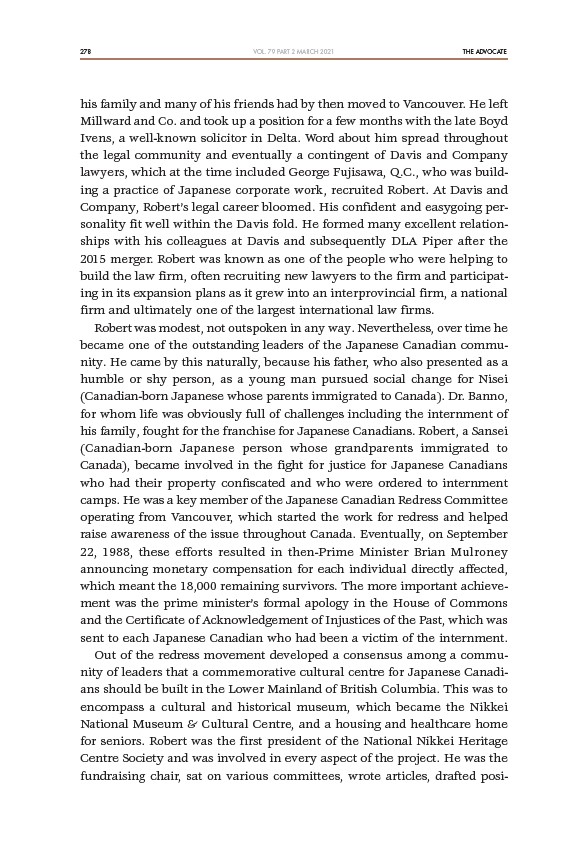
278 THE ADVOCATE
VOL. 79 PART 2 MARCH 2021
his family and many of his friends had by then moved to Vancouver. He left
Millward and Co. and took up a position for a few months with the late Boyd
Ivens, a well-known solicitor in Delta. Word about him spread throughout
the legal community and eventually a contingent of Davis and Company
lawyers, which at the time included George Fujisawa, Q.C., who was building
a practice of Japanese corporate work, recruited Robert. At Davis and
Company, Robert’s legal career bloomed. His confident and easygoing personality
fit well within the Davis fold. He formed many excellent relationships
with his colleagues at Davis and subsequently DLA Piper after the
2015 merger. Robert was known as one of the people who were helping to
build the law firm, often recruiting new lawyers to the firm and participating
in its expansion plans as it grew into an interprovincial firm, a national
firm and ultimately one of the largest international law firms.
Robert was modest, not outspoken in any way. Nevertheless, over time he
became one of the outstanding leaders of the Japanese Canadian community.
He came by this naturally, because his father, who also presented as a
humble or shy person, as a young man pursued social change for Nisei
(Canadian-born Japanese whose parents immigrated to Canada). Dr. Banno,
for whom life was obviously full of challenges including the internment of
his family, fought for the franchise for Japanese Canadians. Robert, a Sansei
(Canadian-born Japanese person whose grandparents immigrated to
Canada), became involved in the fight for justice for Japanese Canadians
who had their property confiscated and who were ordered to internment
camps. He was a key member of the Japanese Canadian Redress Committee
operating from Vancouver, which started the work for redress and helped
raise awareness of the issue throughout Canada. Eventually, on September
22, 1988, these efforts resulted in then-Prime Minister Brian Mulroney
announcing monetary compensation for each individual directly affected,
which meant the 18,000 remaining survivors. The more important achievement
was the prime minister’s formal apology in the House of Commons
and the Certificate of Acknowledgement of Injustices of the Past, which was
sent to each Japanese Canadian who had been a victim of the internment.
Out of the redress movement developed a consensus among a community
of leaders that a commemorative cultural centre for Japanese Canadians
should be built in the Lower Mainland of British Columbia. This was to
encompass a cultural and historical museum, which became the Nikkei
National Museum & Cultural Centre, and a housing and healthcare home
for seniors. Robert was the first president of the National Nikkei Heritage
Centre Society and was involved in every aspect of the project. He was the
fundraising chair, sat on various committees, wrote articles, drafted posi-